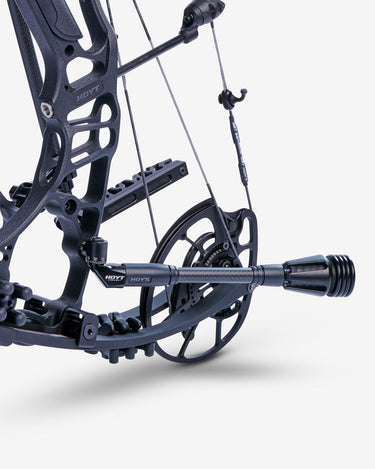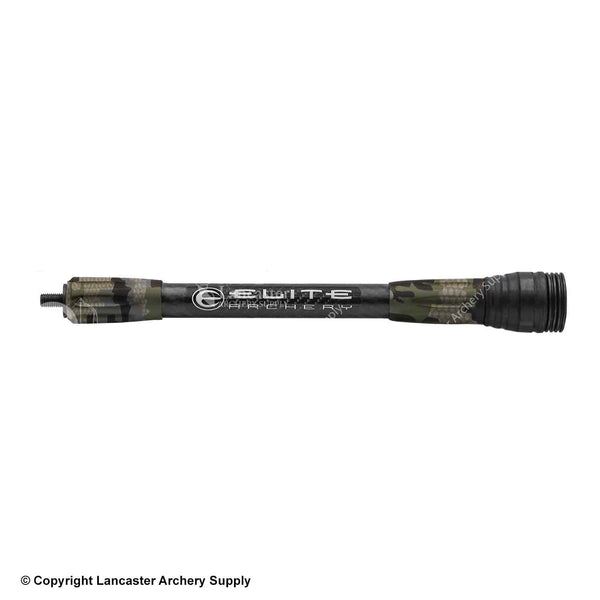Bow Stabilizer Reviews: Locate the Perfect Security Remedy for Your Bow
Bow Stabilizer Reviews: Locate the Perfect Security Remedy for Your Bow
Blog Article
Increase Your Archery Efficiency: The Ultimate Overview to Bow Stabilizer Arrangement
Enhancing your archery performance requires a precise approach to every facet of your equipment configuration. Amongst the different elements that add to accuracy and stability, the bow stabilizer plays an essential role in fine-tuning your shot implementation. Comprehending exactly how to optimize your bow stabilizer configuration can lead to substantial improvements in your total precision and uniformity on the range or in the field. As we dig right into the ins and outs of picking the appropriate stabilizer weight, positioning, and fine-tuning methods, you will certainly reveal the key to opening your full possibility as an archer.
Understanding Bow Stabilizers
In the realm of archery devices, the role and feature of bow stabilizers stand as necessary components for improving shooting precision and stability. Bow stabilizers are made to decrease bow torque, lower vibrations, and assist in holding the bow stable during the intending and launch process. By attaching a bow stabilizer to the riser of the bow, archers can experience better equilibrium and minimized hand shock, resulting in even more consistent and exact shots.
The primary function of a bow stabilizer is to wet any type of vibrations that occur upon releasing the arrow. This decrease in vibration not only boosts the shooter's comfort yet likewise helps preserve emphasis and control throughout the shot cycle. Additionally, bow stabilizers aid in reversing the weight of accessories connected to the bow, such as views, quivers, and arrowhead relaxes, guaranteeing optimum weight circulation for enhanced stability.
Recognizing the mechanics and benefits of bow stabilizers is important for archers wanting to adjust their shooting performance and attain better precision on the range or in the field.

Selecting the Right Stabilizer Weight
Selecting the ideal weight for your bow stabilizer is a crucial element of maximizing your archery setup for enhanced shooting efficiency. The stabilizer weight directly influences just how effectively the stabilizer reduces vibration and maintains your bow during the shot. When picking the appropriate stabilizer weight, it's essential to consider your shooting style, bow equilibrium, and personal preferences.
Lighter stabilizers, typically weighing in between 3-6 ounces, are preferred by archers that prioritize maneuverability and fast target procurement. On the various other hand, larger stabilizers, ranging from 8-12 ounces or even more, are chosen by target archers looking for optimum security and reduced bow activity.
Inevitably, the ideal stabilizer weight for you will certainly depend on your shooting goals and preferences. Explore various weights and finding the one that supplies the optimum equilibrium of security and ability to move is essential to improving your archery efficiency.
Putting Up Your Bow Stabilizer
To appropriately install your bow stabilizer, guarantee that you have all the necessary tools and adhere to these detailed guidelines for a reliable and protected arrangement. Begin by identifying the front stabilizer bushing on your bow riser. A lot of bows have pre-threaded holes for stabilizer installment. Next, use a percentage of bowstring wax to the strings of the stabilizer bolt to stop it from loosening throughout use.
Very carefully thread the stabilizer into the front bushing by hand, seeing to it not to cross-thread it (bow stabilizer). Once the stabilizer is snugly in position, utilize an ideal wrench to tighten it firmly. Stay clear of over-tightening, as this can cause damages to the bow or stabilizer
After setting up the stabilizer, check to ensure it is straight and straightened with the bow. Some stabilizers come with adjustable weights or dampeners; adjust these according to your preferences and shooting style. Examination the bow to ensure the stabilizer is efficiently lowering vibration and enhancing your shot uniformity.
Changing Stabilizer Position for Precision
After mounting the bow stabilizer firmly, optimizing its placement is important for boosting precision in your capturing. The setting of the stabilizer can dramatically influence the equilibrium and stability of your bow during the shot cycle. To adjust the stabilizer for optimal precision, begin by trying out with different settings. Relocating the stabilizer better to the riser can help in reducing the bow's total weight circulation, potentially improving your aiming security. On the other hand, prolonging the stabilizer further out can enhance the bow's mercy and reduce the effects of torque on the shot.
When readjusting the stabilizer placement, take into consideration the kind of shooting you do. For target archery, a longer stabilizer placed further out might be useful for added important site security throughout the aiming procedure. On the other hand, seekers might prefer a much shorter stabilizer for much better ability to move in the field. Bear in mind to make tiny modifications and check your configuration after each change to establish the optimum setting for your capturing design and choices.
Fine-Tuning Your Stabilizer Configuration

Additionally, think about the positioning of any kind of dampeners or weights along the stabilizer pole. Moving these components closer to or further from the riser can change the stabilizer's general effect on your bow's equilibrium. Fine-tuning these information can aid decrease vibration, reduce hand shock, and boost general control throughout the shot execution.
Consistently reassess your stabilizer setup as your capturing technique progresses to discover this info here ensure it remains to enhance your kind and shooting goals. By finetuning your stabilizer arrangement with accuracy and treatment, you can enhance your bow's performance and boost your archery abilities to new heights.
Verdict
To conclude, enhancing your bow stabilizer setup is essential for boosting your archery efficiency. By recognizing the objective of stabilizers, picking the suitable weight, correctly placing i was reading this the stabilizer and setting up, and adjust its arrangement, you can boost your precision and consistency in capturing. Put in the time to explore various setups and changes to locate the setup that functions ideal for you and helps you accomplish your archery goals.
Bow stabilizers are created to decrease bow torque, minimize resonances, and assist in holding the bow stable during the intending and release process. By affixing a bow stabilizer to the riser of the bow, archers can experience enhanced equilibrium and minimized hand shock, resulting in more regular and specific shots.

The stabilizer weight straight affects just how properly the stabilizer minimizes resonance and supports your bow throughout the shot. bow stabilizer. By comprehending the function of stabilizers, choosing the suitable weight, properly positioning the stabilizer and mounting, and adjust its configuration, you can enhance your precision and consistency in capturing
Report this page